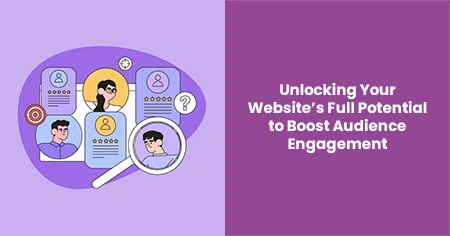Key Strategies to Boost Audience Engagement on Your Website
As you upgrade the digital presence of your business, go beyond attracting visitors because audience engagement is more than page views or traffic numbers. It involves measuring how interested and involved users are once they arrive.
Thus, high engagement often signals that your content is relevant and the user experience is exceptional, which builds trust and encourages return visits. On the other hand, poor engagement often signals that something in the experience needs improvement.
Below, we explore strategies to maximise your website’s potential and create stronger, more lasting audience engagement.
Understand Your Audience and Their Intent
You can’t engage visitors effectively without knowing who they are and what they want. Therefore, start with data. Use tools to observe how people behave on your site. Look at what pages they land on, how long they stay, where they exit, and which actions they take. These insights reveal what content works and what drives them away.
Further, develop user personas that reflect common traits, goals, and pain points. For instance, group your audience based on intent—some users want information, others are ready to buy or sign up. In addition, study your top-performing pages and identify patterns. Are they easier to read? Do they feature clear calls to action or helpful visuals? The answers will help you make informed design and content choices.
Improve User Experience Through Design and Performance
Frustration kills engagement. For instance, slow load times, broken links, cluttered layouts, or poor mobile design can push users away. Thus, first, assess the speed. Optimise image sizes, reduce unnecessary scripts, and choose reliable hosting. Fast-loading pages create a smoother experience that keeps users focused on your content.
Navigation should feel intuitive. Consequently, use a clean, consistent menu structure and limit the clicks it takes to reach key content. On top of that, clear headings and visual hierarchy help users scan and find what they need.
A responsive design adapts to every screen size. More people access websites from phones and tablets, so mobile usability can’t be an afterthought. Accessibility also matters. Use readable fonts, alt text for images, and sufficient colour contrast to ensure your site works for everyone.
Offer High-value, Relevant Content
Content that delivers real value keeps visitors engaged and encourages them to explore further. To create this experience, understand your audience’s needs and challenges. When you know what they care about, you can develop blog posts, videos, and tools that offer practical solutions and timely insights. Avoid filler and use plain language that respects the reader’s time because every content should serve a purpose.
Visual elements like infographics, screenshots, and diagrams can also make complex ideas more accessible while keeping the page visually engaging. As your site grows, review older content to ensure it stays accurate and relevant. Linking related pages creates a natural path for users to explore more of your site. When people consistently find content that speaks to their needs and is easy to consume, they’re far more likely to return, share, and take the next step.
Personalise the Experience Where It Matters
Users are more likely to explore, stay longer, and return when your site reflects individual preferences. Thus, user data helps you present relevant content or offers based on genuine interest rather than assumptions.
Location data also plays a role. For instance, a visitor browsing from Sydney may appreciate different promotions from someone accessing your site from Perth. Use this information to highlight region-specific content or services.
Past interactions offer another layer of personalisation. Show recently viewed products, recommend similar articles, or greet returning users with a custom message. These details make your site feel responsive and intentional, not generic. The result is a more personal experience that strengthens connection and improves outcomes across every touchpoint.
Include Interactive Elements and Opportunities for Feedback
When users participate, they engage more. For instance, polls and quizzes offer quick, engaging ways to respond while collecting insights. These tools keep people on your site longer and give them a reason to return.
Further, surveys help you understand what users like or want more of. Instead of guessing, ask direct questions. The answers can guide improvements and make users feel valued. If someone knows their opinion matters, they’re more likely to stay involved. Live chat adds immediate value. A visitor who gets a quick answer is less likely to bounce and more likely to convert.
Strengthen Calls to Action and Conversion Paths
Calls to action (CTA) guide users toward meaningful steps. A strong CTA makes the user want to take action. Use direct, benefit-focused language that reflects the intent. For instance, prompts like ask for a free quote and start learning today are more effective than vague ones like click here.
Placement also matters. Put CTAs where interest is highest, such as after a compelling paragraph or product showcase. However, don’t overwhelm the page with too many buttons. Instead, lead visitors through a logical path with one clear goal per section.
Each action should feel like a natural next step. If someone reads a guide, offer a related resource or consultation. If a person views a product, suggest a trial or add-to-cart prompt. In addition, eliminate obstacles like long forms or unclear instructions because simplicity increases follow-through.
Track Engagement and Continuously Optimise
Guesswork leads to wasted effort. Hence, use data to understand how visitors interact with your site, then refine the experience based on what you learn. For instance, metrics like bounce rate, time on page, and click paths show where people lose interest or get stuck. Something needs to change if a page sees high traffic but low conversion.
Testing reveals what works. A/B testing lets you compare headlines, layouts, or CTA placements. Even minor adjustments like a rewritten headline or a clear button can have a measurable impact. Over time, these changes build a smoother, more engaging user experience.
User testing adds another layer. For instance, watching how people navigate your site uncovers pain points that analytics alone might miss. In addition, feedback from real users helps validate your design and content decisions.
Build Trust Through Transparency and Credibility
People engage more when they trust your website. That trust often starts with clear, honest communication. Hence, displaying reviews and testimonials gives new visitors confidence that others have had positive experiences with your business. Use full names and, where appropriate, photos to make these endorsements feel real.
Trust signals also include visible privacy policies, clear refund or return terms, and contact details that are easy to find.
Credentials also matter. Hence, make certifications and memberships visible. These small details show that you are legitimate and accountable. Trust also grows when you avoid exaggerated claims by delivering accurate, balanced information instead of hype.
A transparent site creates fewer doubts. Visitors who feel confident in your credibility are more likely to stay longer, sign up, or make a purchase.
Leverage Email Signups and Retargeting Wisely
Many visitors will not convert on their first visit. Hence, email signups and retargeting help keep your site in their minds even after they leave. Offer something valuable in exchange for an email address—a guide, discount, or exclusive content. Keep the form short and clearly explain what the user will receive. Once someone joins your list, follow up with a series of personalised messages that match their interests.
Avoid flooding inboxes with too many emails. Instead, focus on relevance and timing. If someone browsed a product or read a blog post, send a follow-up email that offers more information on that topic. This kind of personal attention builds a stronger connection and encourages return visits.
Retargeting serves a similar purpose. Use ads to remind users of what they viewed or abandoned in their cart. You can show them something familiar and give them a reason to revisit the site. When used thoughtfully, email and retargeting extend engagement beyond your site and bring visitors closer to conversion
Foster a Consistent Brand Voice Across the Site
A clear and consistent voice helps people feel connected to your business. Whether your tone is professional, friendly, or conversational, it should match your brand identity and remain consistent across all pages.
Start with your homepage and carry that tone through every element—headlines, calls to action, product descriptions, blog posts, and even error messages. Consistency builds recognition. The voice should feel familiar and cohesive if a visitor reads one article and later sees your product page.
Avoid switching between formal and casual language because it creates confusion and weakens your message. Instead, use words and phrasing that reflect your values and speak directly to your target audience.
Use Social Proof to Reinforce Engagement
Highlight the number of users who have tried your service or the results others have achieved. If trusted media feature your products, include those logos or quotes. In addition, visible signs of popularity, like download counts or social media shares, can influence how users perceive your value.
User-generated content works well. Therefore, invite your audience to post photos, reviews, or feedback and display that content across your site. When people see others engaging, they feel more inclined to join in.
Create a Seamless Multichannel Experience
Every digital channel you use—social media, email, paid ads, or even offline campaigns—should support and enhance the website experience. Users should see one consistent brand when they move between platforms.
Start by aligning visuals and messaging. The tone, design, and language used in your emails or Instagram posts should match what visitors find on your site. If someone clicks a promotion on social media, the landing page should reflect the same offer and message.
Include social follow buttons, newsletter signups, and links to relevant content from different platforms to make it easy for users to move between channels. Each interaction should support the next, guiding the user deeper into the experience.
Conclusion
A well-designed website does more than deliver information. It creates a space where users feel understood, supported, and encouraged to take action. Genuine engagement comes from combining thoughtful content with purposeful features that invite interaction.








